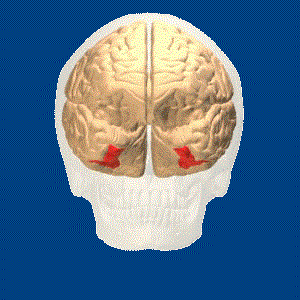
WHAT IS PROSOPAGNOSIA?
Prosopagnosia, also called face blindness, is a cognitive disorder of face perception in which the ability to recognize familiar faces, including one's own face (self-recognition), is impaired, while other aspects of visual processing (e.g., object discrimination) and intellectual functioning (e.g.,decision making) remain intact.
The term originally referred to a condition following acute brain damage (acquired prosopagnosia), but a congenital or developmental form of the disorder also exists, which may affect up to 2.5% of people. The specific brain area usually associated with prosopagnosia is the fusiform gyrus, which activates specifically in response to faces.

TYPES OF PROSOPAGNOSIA
APPERCEPTIVE
Apperceptive prosopagnosia has typically been used to describe cases of acquired prosopagnosia with some of the earliest processes in the face perception system. The brain areas thought to play a critical role in apperceptive prosopagnosia are right occipital temporal regions. People with this disorder cannot make any sense of faces and are unable to make same-different judgements when they are presented with pictures og different faces. They are unable to recognize both familiar and unfamiliar faces. In addition, apperceptive sub-types of prosopagnosia struggle recognizing facial emotion. However, they may able to recognize people based on no-face clues such as their clothing, hairstyle, skin colour or voice.
ASSOCIATIVE
Associative prosopagnosia has typically been used to describe cases of acquired prosopagnosia with spared perceptual processes but impaired links between early face perception processes and the semantic information we hold about people in our memories. Right anterior temporal regions may also play a critical role in associative prosopagnosia. People with this form of the disorder may be able to see whether photos of people's faces are the same or different and derive the age and sex from a face (suggesting they can make sense of some face information) but may not be able to subsequently identify the person or provide any information about them such as their name, occupation, or when they were last encountered.
DEVELOPMENTAL
Developmental prosopagnosia (DP), also called congenital prosopagnosia (CP), is a face-recognition deficit that is lifelong, manifesting in early childhood, and that cannot be attributed to acquired brain damage. A number of studies have found functional deficits in DP both on the basis of EEG measures and fMRI. It has been suggested that a genetic factor is responsible for the condition. The term "hereditary prosopagnosia" was introduced if DP affected more than one family member, essentially accenting the possible genetic contribution of this condition. To examine this possible genetic factor, 689 randomly selected students were administered a survey in which seventeen developmental prosopagnosics were quantifiably identified. Family members of fourteen of the DP individuals were interviewed to determine prosopagnosia-like characteristics, and in all fourteen families, at least one other affected family member was found.
In 2005, a study led by Ingo Kennerknecht showed support for the proposed congenital disorder form of prosopagnosia. This study provides epidemiological evidence that congenital prosopagnosia is a frequently occurring cognitive disorder that often runs in families. The analysis of pedigree trees formed within the study also indicates that the segregation pattern of hereditary prosopagnosia (HPA) is fully compatible with autosomal dominant inheritance. This mode of inheritance explains why HPA is so common among certain families (Kennerknecht et al. 2006).
Understanding Prosopagnosia